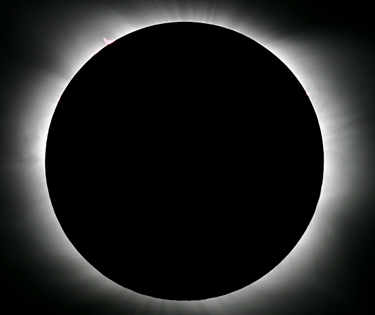 This week, the SciFi Channel is running a miniseries called Tin Man. I haven’t watched it (you can view all three episodes at www.scifi.com), but one of my astronomy friends tells me tonight’s episode features a double solar eclipse — two moons covering the fictional planet’s two suns.
This week, the SciFi Channel is running a miniseries called Tin Man. I haven’t watched it (you can view all three episodes at www.scifi.com), but one of my astronomy friends tells me tonight’s episode features a double solar eclipse — two moons covering the fictional planet’s two suns.
This got me thinking about eclipses, both past and future. On August 1, 2008, I’ll be in Novosibirsk, Russia, enjoying 2 minutes 18 seconds of totality. This promises to be a great trip, and I’ll blog about it in more detail soon.
The past eclipse that came to mind wasn’t a total one, but, rather, the annular eclipse of May 30, 1984. An annular eclipse features the Moon passing directly across the Sun’s face, but, for such an eclipse, the Moon lies too far from Earth to cover the Sun completely. Thus, a ring (annulus in Latin) appears around the eclipsed Sun.
This particular eclipse was quite the adventure. Brad, a friend’s 13-year-old son and I loaded my maxi-van with snacks, sodas, beanbag chairs, and my Apple (not Macintosh) computer. For most of the trip, Brad sat in back playing — I kid you not — text-based computer adventure games. How times have changed!
Earlier in the school year, I had asked Brad’s parents if he could accompany me on the trip. Because the timing meant he’d miss the last week of school, they made a deal with him: Make straight-As and the trip was on. What incentive!
From Hutchinson, Kansas, we headed to Memphis, Tennessee, to pick up Ray Shubinski, now a contributing editor of Astronomy. I recall Brad and I made the trip without stopping. That van didn’t get great mileage, but it had a 48-gallon gas tank.
I’d brought my 2.4-inch Unitron refractor along. This eclipse predated my bout of aperture fever (the desire for ever-larger telescopes, irrespective of the size you own). Ray, for his part, brought a fine 8-inch Schmidt-Cassegrain telescope.
We headed south from Memphis and set up in a graveyard in Picayune, Mississippi. The residents didn’t seem to mind, and we were respectful. We observed late into the night but still awoke early enough to see the Sun rise.
Just before the eclipse began, another amateur astronomer from Canada joined us in the cemetery. The four of us (five, if you count my German Shepherd) enjoyed superb conditions throughout the event. The temperature dropped 17° F in our location, birds came in to roost, and we saw Venus. But it wasn’t totality. The difference between an annular and a total solar eclipse is like almost dying compared to dying. In other words, there’s no comparison.
Totality is the most dramatic natural event anyone will experience. Just once in your life you should stand under an eclipsed Sun at midday. After that, you’ll know what I’m raving about.